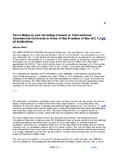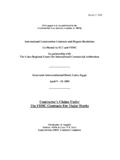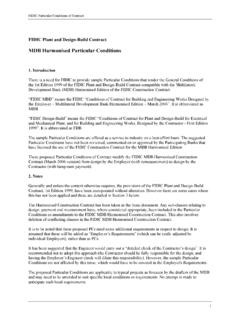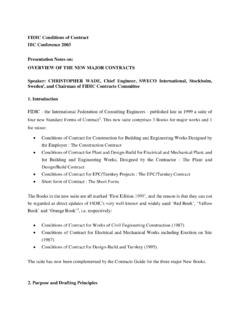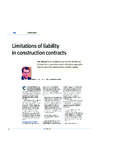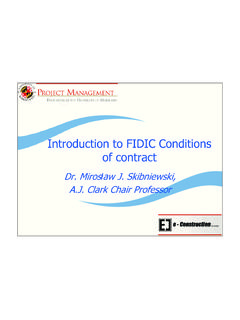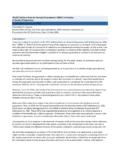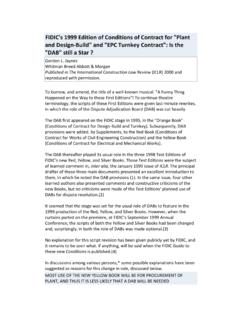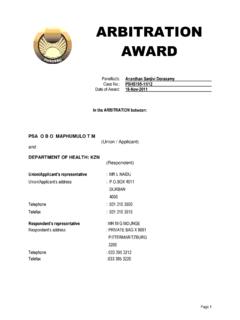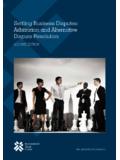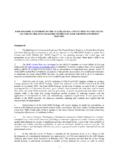Transcription of CLAUSE 20, DISPUTE RESOLUTION - FIDIC
1 CLAUSE 20, DISPUTE RESOLUTION Michael Mortimer-Hawkins FIDIC Contracts Committee Introduction Before looking at the provisions of CLAUSE 20 in the 1999 FIDIC Conditions, let us remind ourselves of the system used prior to the introduction of the DISPUTE Adjudication Board. In the pre-1999 documents (for example, in CLAUSE 67 of the old Red Book), the procedure for handling claims and disputes involved principally the Engineer making a fair and impartial determination and decision which was binding on the parties unless and until either party was dissatisfied with that decision and chose to take the matter one stage further - and that was arbitration.
2 This procedure worked well for many years until some people - notably lawyers and the World Bank - began questioning whether the Engineer (as a Party paid by the Employer) could realistically be expected to act in the manner required by CLAUSE 67 -that is "impartially". After much debate on the subject, the World Bank in the early 1990's, took the step of requiring Borrowers who were carrying out work based on the old 1987 Red Book, to amend CLAUSE 67 to replace the Engineer's Decision with a totally independent DISPUTE Review Board (DRB) as a pre-arbitral attempt to reach agreement on potential DISPUTE situations.
3 The DRB would make a `recommendation' which it was hoped the parties would accept, but they were free to reject and refer the matter to arbitration if they so wished. In 1996, FIDIC decided to publish a supplement to the Red Book providing a revised text to CLAUSE 67 to be used if the parties decided to adopt an alternative form of DISPUTE RESOLUTION along the lines of the Bank's DRB. FIDIC felt that for such a procedure to be effective, the decision of the DISPUTE board should be binding rather than just a recommendation, and thus introduced the DISPUTE Adjudication Board (DAB).
4 The purpose and role of the DAB was covered in the 1996 Supplement and formed the basis of the procedures described in CLAUSE 20 of the 1999 documents. More recently, the WB, whilst retaining the name DRB, have made the findings of the DRB binding on the parties (similar to FIDIC 's DAB). It is also interesting to note that, historically, the process of adjudication as we now find it in the FIDIC documents, is very similar to the process of arbitration as it was when it was first introduced as a means of solving disputes several hundred years ago (12"I' Century). At that time (for example), two tradesmen with a difference of opinion about the price of potatoes, would put the matter before a `commercial court' (rather than a court of law), consisting of other tradesmen with similar experience to make a decision.
5 Then God invented lawyers and the whole process became a completely different ball-game. In 1697, the first Arbitration Act was passed in an attempt to regulate arbitration proceedings, and since then the process has become more and more based on legal principles rather than on common sense. But now, common sense is prevailing again and we are re-inventing the process (and calling it adjudication) to protect ourselves against legal nightmares surrounding the arbitration process today. The procedures I am going to run through are those found in CLAUSE 20 of the new Red Book - Conditions of Contract for Construction.
6 CLAUSE 20 - Claims, disputes and Arbitration So let us move on to CLAUSE 20 as it appears in the new FIDIC documents. This is very similar to the Supplement to the 1987 fourth edition issued in 1996 whereby the Engineer's Decision under CLAUSE 67 (which is very similar to CLAUSE 66 of the Irish Conditions) was replaced by a DAB. In this presentation I will be referring to the 1999 FIDIC CLAUSE 20. In the old documents, there were different clauses dealing with Claims and disputes , so let us just clarify what is what. A Claim is essentially a request from one party (usually the Contractor) for something which he considers is due to him under the terms of the Contract - and a DISPUTE arises when the other party disagrees with the Claimant either on fact or quantum, and the parties cannot reach an amicable solution.
7 So CLAUSE 20 is there to allow Contractors their basic right to claim additional compensation (money or time) in the event that they (the Contractors) feel they have an entitlement under the Contract to such compensation. And it goes on to provide a mechanism for handling those claims and any disputes which may arise as a result. As compared to the provisions of the old Red Book (apart from the introduction of the DAB), the 1999 documents have tried to tighten up the rules and procedures concerning all claims and remove some of the weaknesses and loopholes found in the earlier documents.
8 Contractor's Claims This sub- CLAUSE has been written to give a precise procedure which Contractors must follow if they wish to submit a claim - either for extra cost or extra time. In the past there has often been disagreement as to how to act in the event that a Contractor has failed to submit a claim within the given time limit. Does the Engineer look at the claim or does he not? Or is lie empowered to or indeed does he have a duty to? Or indeed, what are his rights according to the law? Remember also that when the Contractor submits a claim, the burden of proof lies with the Contractor. It is the Contractor's job to prove his case - it is the Engineer's job to evaluate the evidence and decide whether the case is proven.
9 The first step is for the Contractor to give Notice. This he must do within 28 days of becoming aware of the event. This Notice is important because: everyone involved becomes aware that here is an event or circumstance where extra time or payment may be due to the Contractor proper records can then be kept and agreed, to avoid future argument alternative measures may also be possible to reduce the effects maybe the matter can be resolved at an early date if the event or circumstance turns out to be of insignificant effect, then it is not necessary to follow up the Notice with a formal claim. There are many individual Sub- clauses which give the Contractor (or the Employer) entitlement to claim extension of time or additional payment.
10 In the various Sub- clauses the Contractor's entitlements to claim are expressed similarly, 'If the Contractor suffers delay and/or incurs Cost .. the Contractor shall give notice .. and shall be entitled subject to SubClause to: (a) an extension of time .. (b) payment of any such ' Thus ALL claims from the Contractor have to follow the procedure set out in Cl. It is a procedural CLAUSE . The Notice must also give basic details describing the event or circumstance the notice need not state time or amount claimed or contractual basis of claim notice shall comply with Cl , in writing and properly delivered progress reports - Cl (f) - must list notices given no response required from Engineer (Employer) - but a simple acknowledgement is normal.
